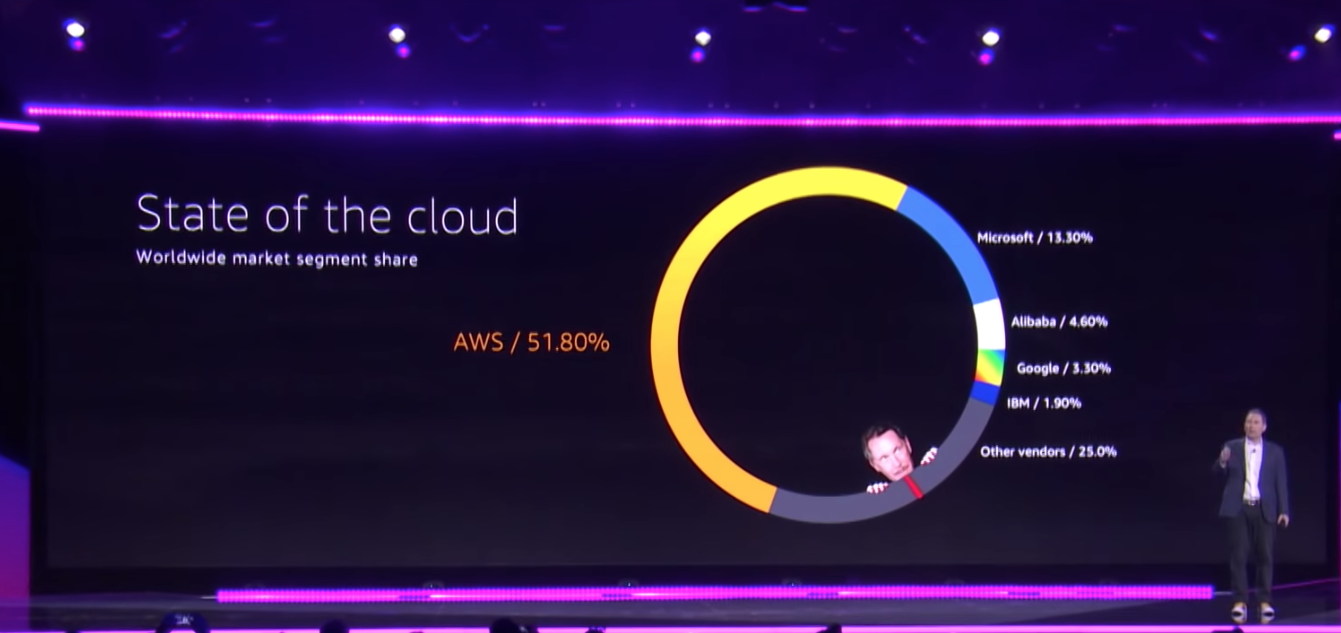On Wednesday morning, this is the big day for AWS re:Invent conference. The day started with a 3 hours keynote from Andy Jassy, CEO of AWS.The keynote covered a lot of different topics: databases, blockchain, machine learning… As most keynotes, it started with some numbers and AWS is still a strong leader on the public Cloud if you look at the market shares, a moment to tackle a bit some known competitors.
Then it’s also the occasion for lots of announces and new services launches. If I have to make a selection, here is a few:
- AWS Timestream: a new database service focusing on data from time series designed for IoT data that may come from sensors
- AWS Quantum Ledger Database (QLDB): a new database service to answer some needs where customers were looking at the blockchain
- AWS Glacier Deep Archive: the goal is to forget about backup to tape with a very competitive price of 1$ per TB (0.00099 $ per GB)
- AWS Security Hub: to manage security and compliance across an AWS environment
Andy Jassy also announced a competition for machine learning developer AWS DeepRacer league. The goal is to create an autonomous driving model so the AWS DeepRacer (small electric car) finish a lap of a test track the fastest way possible. It’s reinforcement learning with a try and error where the model improves itself using the feedback of previous iterations. For this year developers will have 1 day and the 3 best will compete in a final before Thursday’s morning keynote.
After the keynote, I continued to pick sessions around databases and AWS introductory sessions about the infrastructure.
The one about matching the workload with the right database was very interesting. Basically, Rick Houlihan was explaining that you have to know your knowledge before picking the engine you will use. Most often, the engine is picked because it’s already licensed or because there is already an operational team knowing how to operate it. Also it happens that some people tries to go to the latest or newest trend because of the buzz. According to him, relational databases are not scaling very well and are optimized for storage. That’s true that if you fully normalize, data is not supposed to be duplicated. On the other hand, NoSQL databases can scale a lot but are not very adaptive to ad-hoc queries.
On the architecture part, I focused again on VPC and there are some changes on how you can build your network to work on AWS alongside with your on premise datacenter.
VPC sharing allows now a VPC to span across different AWS account within the same organization. It means you can have several billing accounts but managed by a VPC owner that would be responsible for routing tables and so. It can simplify the maintenance and help network engineers.
The other big point I noted is the new transit gateway (TGW). A transit gateway can be attached to several VPCs and to AWS VPN to link with your datacenter. This is a central hub where you can maintain routing tables for inter-VPC traffic without maintaining a virtual private gateway per VPC.
On Thursday, there will be another keynote from Dr Werner Vogels, CTO of Amazon.com. Let’s see if there will be other announces.




![Thumbnail [60x60]](https://www.dbi-services.com/blog/wp-content/uploads/2022/11/NIJ-min-scaled.jpg)
![Thumbnail [90x90]](https://www.dbi-services.com/blog/wp-content/uploads/2022/08/STH_web-min-scaled.jpg)